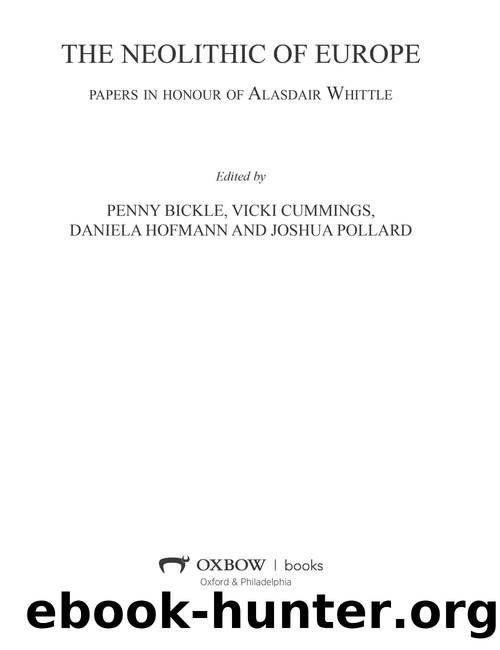The Neolithic of Europe by Penny Bickle Daniela Hofmann Joshua Pollard

Author:Penny Bickle,Daniela Hofmann,Joshua Pollard
Language: eng
Format: epub
ISBN: eBook ISBN: 9781785706554
Publisher: Casemate Publishers & Book Distributors, LLC
Published: 2017-07-14T16:00:00+00:00
10
Size matters? Exploring exceptional buildings in the central European early Neolithic
Daniela Hofmann and Eva Lenneis
Introduction: about the longhouse
‘The longhouse was the central fact of LBK existence’, as Alasdair Whittle (2012, 195) once put it, and it has remained an enduring concern in his work over the years. His contribution has always challenged received ideas about the house, be this in terms of the size of the social unit inhabiting it, the idea of autonomous households, or more recently the controversy between alternative yard and row settlement models or the applicability of the ‘house society’ concept (e.g. Whittle 1988, 67–73; 1996, 162–7; 2001; 2003, 134–43; 2009; 2012). Instead, he has stressed the ways in which the longhouse brought a range of diverse people together, functioning as a focal point within a meshwork of relations. He has also addressed the mythological and symbolic aspects of the building, most recently suggesting a homology between the human body and the house (Whittle 2012).
In contrast, the question of why the LBK house follows a relatively predictable modular pattern, long established by Modderman (1970; 1972), has been of more passing interest, although he has addressed the problematic relations between house size and partition (Whittle 1988, 69–73). Elsewhere, the significance of partition is much debated, sometimes with the same aim to find ‘the’ single correct answer that Alasdair has also noted for settlement patterns (e.g. Whittle 2012, 196). Initially, it was argued that the three parts of the house served different economic functions – for instance cattle stalling in the back with its planked walls, cereal storage in the front with its double posts, and general everyday activities in the centre (Modderman 1970, 101–9). For Van de Velde (1990) tripartition was connected with the status of the inhabitants, with tripartite structures associated with greater numbers of adzes at some of the Langweiler sites, but this remained difficult to substantiate elsewhere. Others have pointed towards house length as an indicator of extensive networks and, indirectly, status (Hofmann 2012). In contrast, for Coudart (2015) the tripartite house is intimately bound up with the maintenance of egalitarian relations, whereby houses with an extensive front end were responsible for storing and redistributing the community’s grain, always under the careful scrutiny of others.
However, it is now being recognised that there may be more diversity in how the building was actually inhabited, as well as in the importance accorded to clear internal partitioning. This is true for example in Poland, where it can be difficult to discern three parts based on the post constellations inside the house (e.g. Czerniak 2016, 47–53). In her comprehensive work, Coudart (1998) also pointed out that none of the houses in the Paris basin show three parts as described by Modderman. At this western edge of the LBK and in this late phase of the culture, one can only distinguish between large and small houses on the basis of the number of post rows in the rear parts of the buildings, i.e. behind the back corridor, but there are no front modules any more (Hachem 2011, 212, fig.
Download
This site does not store any files on its server. We only index and link to content provided by other sites. Please contact the content providers to delete copyright contents if any and email us, we'll remove relevant links or contents immediately.
The Daily Stoic by Holiday Ryan & Hanselman Stephen(2706)
The Fate of Rome: Climate, Disease, and the End of an Empire (The Princeton History of the Ancient World) by Kyle Harper(2434)
People of the Earth: An Introduction to World Prehistory by Dr. Brian Fagan & Nadia Durrani(2346)
Ancient Worlds by Michael Scott(2102)
Babylon's Ark by Lawrence Anthony(2069)
Foreign Devils on the Silk Road: The Search for the Lost Treasures of Central Asia by Peter Hopkirk(2054)
India's Ancient Past by R.S. Sharma(1984)
MOSES THE EGYPTIAN by Jan Assmann(1970)
The Complete Dead Sea Scrolls in English (7th Edition) (Penguin Classics) by Geza Vermes(1838)
Lost Technologies of Ancient Egypt by Christopher Dunn(1797)
The Daily Stoic by Ryan Holiday & Stephen Hanselman(1767)
The Earth Chronicles Handbook by Zecharia Sitchin(1743)
24 Hours in Ancient Rome by Philip Matyszak(1676)
Alexander the Great by Philip Freeman(1645)
Aztec by Gary Jennings(1543)
The Nine Waves of Creation by Carl Johan Calleman(1519)
Curse Tablets and Binding Spells from the Ancient World by Gager John G.;(1510)
Before Atlantis by Frank Joseph(1483)
Earthmare: The Lost Book of Wars by Cergat(1466)
